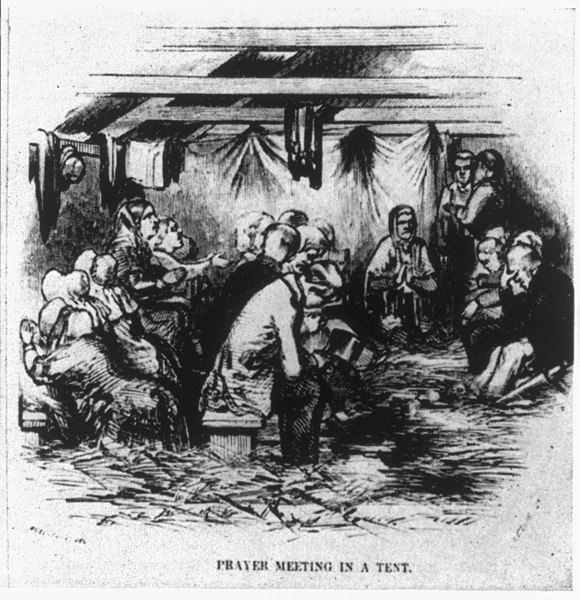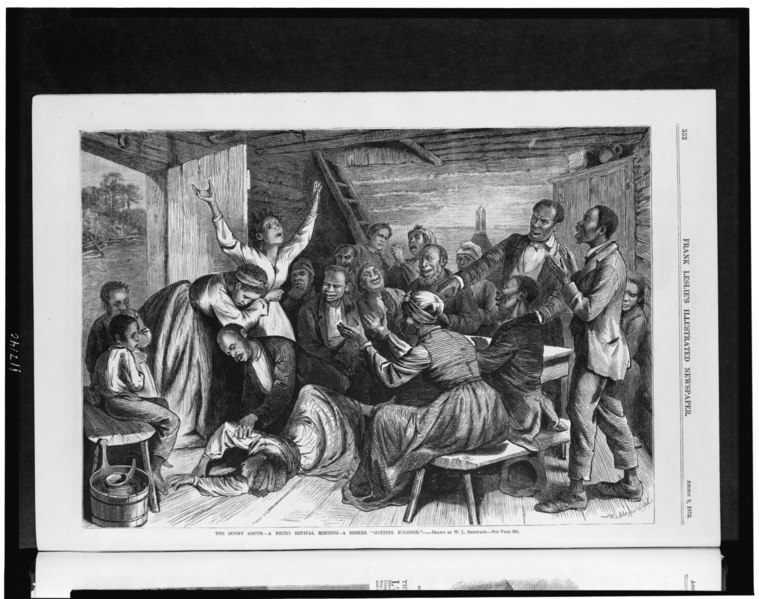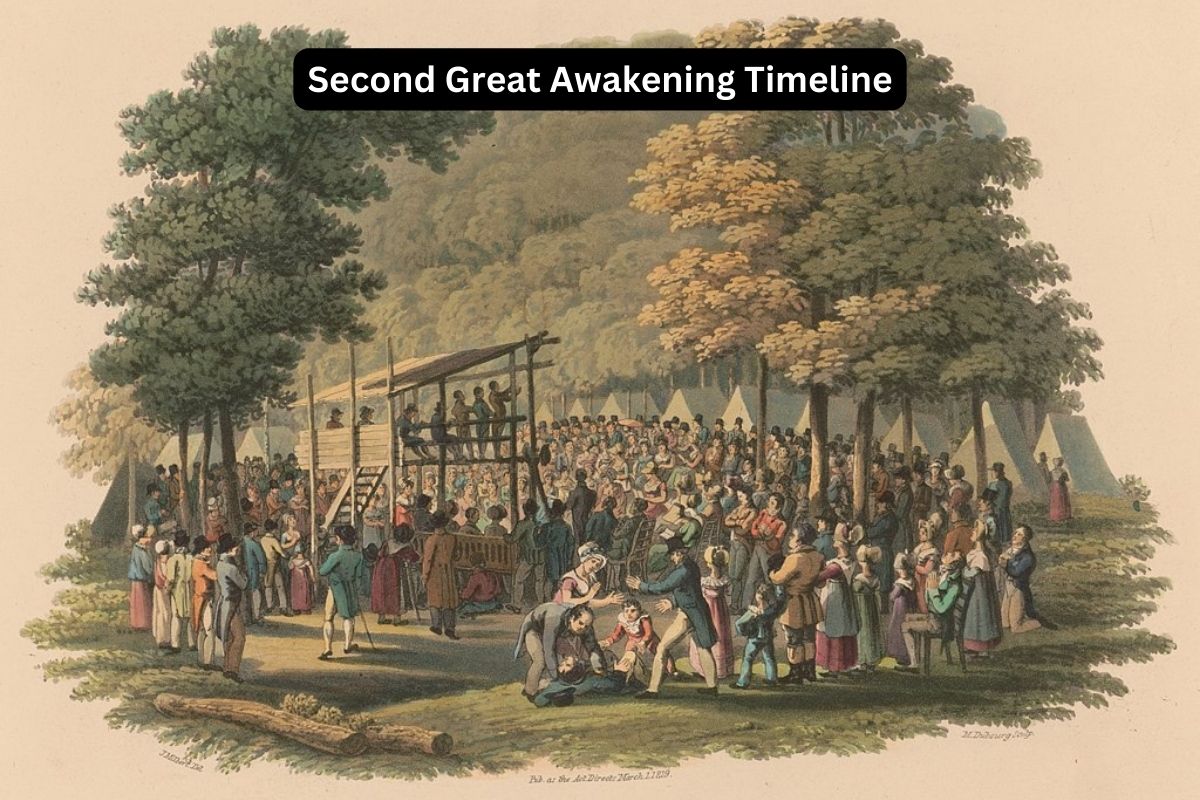The Second Great Awakening was a transformative religious revival movement that swept across the United States during the early to mid-19th century.
This period of fervent religious enthusiasm, which followed the First Great Awakening of the 18th century, had a profound impact on American society.
It reshaped religious practices, led to the rise of various Protestant denominations, and influenced social and political movements, including abolitionism and women’s rights.
In this era, charismatic preachers, camp meetings, and emotional religious experiences played significant roles in shaping the spiritual and moral landscape of the nation.
| Year | Event |
|---|---|
| Late 18th Century | – 1790s: The First Great Awakening begins to wane but leaves a lasting impact on American religious culture. |
| Early 19th Century | – 1801-1803: The Cane Ridge Revival in Kentucky, led by ministers Barton W. Stone and Cane Ridge Revival Timeline. – 1804: The Western Revival, also known as the Kentucky Revival, led by Presbyterian minister James McGready, spreads across Kentucky and Tennessee. – 1806: The Red River Revival, led by James McGready and Barton W. Stone, continues to promote religious enthusiasm in the frontier regions. – 1808: Charles Finney, a prominent figure in the Second Great Awakening, is born in Warren, Connecticut. |
| 1810s | – 1811-1812: The New Madrid earthquakes in the Mississippi Valley lead some to interpret them as divine warnings and contribute to religious fervor. – 1816: The American Bible Society is founded in New York City, promoting the distribution of Bibles. – 1817: The Cumberland Presbyterian Church is established in Tennessee. – 1818: Charles Finney converts to Christianity and later becomes a leading revivalist preacher. |
| 1820s | – 1820: The publication of the Book of Mormon marks the founding of the Church of Jesus Christ of Latter-day Saints (Mormonism). – 1824: The Second Great Awakening begins to intensify, with revivals spreading throughout the eastern United States. – 1826: Charles Grandison Finney becomes a prominent revivalist preacher, conducting revivals throughout the United States. – 1827: The Methodist Episcopal Church splits into the Methodist Episcopal Church and the Methodist Protestant Church. |
| 1830s | – 1830: Joseph Smith formally organizes the Church of Jesus Christ of Latter-day Saints (Mormon Church). – 1831: The Nat Turner slave rebellion in Virginia sparks debates about the role of religion in slave uprisings. – 1833: The Oberlin College in Ohio becomes a center for revivalist and abolitionist activities under the leadership of Charles Finney. – 1839: The Burned-Over District in New York becomes a hotbed of revivalist activity. |
| Late 1830s to Early 1840s | The Second Great Awakening begins to decline in intensity, but its impact on American religious and social life persists. |
Timeline of the Second Great Awakening
Late 18th Century:
First Great Awakening (1730s-1740s): The Second Great Awakening was preceded by the First Great Awakening, which took place in the 1730s and 1740s.
During this earlier religious revival, notable figures like George Whitefield and Jonathan Edwards played a significant role in stirring religious enthusiasm among American colonists.
Also Read: Facts About the Second Great Awakening
The First Great Awakening had a lasting impact on American religious culture, emphasizing personal conversion and a more emotional approach to faith.

Early 19th Century:
Cane Ridge Revival (1801-1803): The Cane Ridge Revival was a significant event during the early years of the Second Great Awakening. It occurred in Cane Ridge, Kentucky, and was led by ministers Barton W. Stone and Cane Ridge Revival Timeline.
Also Read: The Enlightenment Facts
The revival drew thousands of people who participated in emotional and spontaneous religious gatherings, marked by shouting, dancing, and speaking in tongues.
It is often considered a precursor to the larger Second Great Awakening movement.
Western Revival (Kentucky Revival) – 1804: In the wake of the Cane Ridge Revival, the religious fervor continued to spread, particularly in the frontier regions of Kentucky and Tennessee.
Presbyterian minister James McGready played a leading role in this “Western Revival.” McGready’s fiery sermons and emotional appeal contributed to a surge in conversions and religious enthusiasm among settlers in these areas.
The revivals during this time emphasized the need for personal salvation and a more active Christian life.
Red River Revival – 1806: The Red River Revival was another important event in the early years of the Second Great Awakening, closely related to the Western Revival. It was led by ministers James McGready and Barton W. Stone, who promoted camp meetings and open-air revivals.
These gatherings attracted large crowds and were characterized by emotional religious experiences. The Red River Revival contributed to the growth of various Protestant denominations in the region.
Birth of Charles Finney (1808): Charles Grandison Finney, a central figure in the Second Great Awakening, was born in Warren, Connecticut, in 1808. He would later become one of the most influential revivalist preachers of the era.
Finney’s innovative preaching methods and emphasis on revival meetings played a significant role in the spread of the Second Great Awakening throughout the United States.
American Bible Society (1816): The founding of the American Bible Society in 1816 marked an important development during the Second Great Awakening.
This organization was established in New York City with the goal of promoting the distribution and accessibility of the Bible to people across the United States.
The American Bible Society played a crucial role in making the Bible more widely available, fostering Bible reading, and contributing to the religious fervor of the era.
Cumberland Presbyterian Church (1817): In 1817, during the early years of the Second Great Awakening, the Cumberland Presbyterian Church was established in Tennessee.
This denomination emerged as a result of the revivalist activities in the region. It emphasized evangelical and revivalist theology, and its formation reflected the broader trend of new religious groups and denominations forming during this period.
The Cumberland Presbyterian Church played a role in shaping the religious landscape of the American frontier.
Charles Finney’s Conversion (1818): Charles Grandison Finney’s personal conversion to Christianity in 1818 is significant in the context of the Second Great Awakening.
Finney, who would later become one of the most prominent and influential revivalist preachers of the era, experienced a powerful religious conversion that led him to commit his life to spreading the Christian message.
His conversion experience fueled his passion for revivalism and evangelism, and he went on to conduct numerous revival meetings across the United States.
The Book of Mormon (1820): In 1820, Joseph Smith claimed to have received divine revelations and unearthed ancient golden plates, which he translated into what is now known as the Book of Mormon.
This event marked the founding of the Church of Jesus Christ of Latter-day Saints, commonly referred to as Mormonism.
The Book of Mormon became a foundational religious text for the new faith, and Joseph Smith’s teachings contributed to the religious landscape of the United States during the Second Great Awakening.
Methodist Episcopal Church Split (1827): In 1827, the Methodist Episcopal Church in the United States experienced a significant split. This division led to the formation of two separate denominations:
- The Methodist Episcopal Church (MEC)
- The Methodist Protestant Church (MPC).
The split was partly a response to concerns about church governance and clergy appointments within the Methodist Episcopal Church.
The Methodist Protestant Church emerged as a more democratic alternative, and this split reflected some of the tensions and transformations within American Protestantism during the Second Great Awakening.
Founding of the Church of Jesus Christ of Latter-day Saints (1830): In 1830, Joseph Smith officially organized the Church of Jesus Christ of Latter-day Saints (commonly known as the LDS Church or Mormon Church).
This event followed his claims of divine revelations and the publication of the Book of Mormon in 1830. The founding of the LDS Church marked a significant development during the Second Great Awakening.
The church’s unique teachings, including the belief in additional scriptures like the Book of Mormon, the practice of baptism for the dead, and the concept of modern-day prophets, set it apart from mainstream Christianity.
The LDS Church played a prominent role in the religious landscape of the United States and continues to do so to this day.

Nat Turner’s Rebellion (1831): Nat Turner’s slave rebellion in Southampton County, Virginia, in 1831 had profound consequences during the Second Great Awakening.
Turner, a black preacher, believed he was receiving divine messages and led a violent uprising against slaveholders. The rebellion and its brutal suppression led to debates about the role of religion in slave uprisings.
While some slaveholders argued that religious gatherings and conversion to Christianity could lead to insurrection, others saw religion as a means of pacifying enslaved individuals.
Oberlin College (1833): Oberlin College, founded in Oberlin, Ohio, in 1833, played a significant role during the Second Great Awakening.
Under the leadership of Charles Finney, who became its president, Oberlin College became a center for revivalist and abolitionist activities. The college embraced progressive ideas, including coeducation and the admission of African American students.
It became known for its commitment to social reform, religious revivalism, and the promotion of Christian values. Oberlin’s influence extended beyond its campus, contributing to the larger movements for abolitionism and women’s rights.
Some key points about Oberlin College:
- Progressive Ideals: Oberlin College embraced progressive ideas, such as coeducation, admitting both men and women as students. This was a pioneering move in higher education and reflected a commitment to gender equality in educational opportunities.
- Inclusion of African American Students: Oberlin College was one of the first American colleges to admit African American students. The institution actively promoted the education of Black individuals, and many African American graduates became leaders in the abolitionist movement.
- Social Reform and Christian Values: Oberlin College’s commitment to social reform, religious revivalism, and the promotion of Christian values made it a unique institution during the Second Great Awakening. Its influence extended beyond its campus, as many of its graduates played significant roles in the abolitionist and suffragist movements, contributing to the broader societal changes of the era.
Late 1830s to Early 1840s:
During this period, the Second Great Awakening began to evolve and decline in intensity, but its impact on American religious and social life continued. Several notable events and trends characterized this phase:
Burned-Over District Revivals: The region of upstate New York became known as the “Burned-Over District” due to the intensity of religious revivals and the frequency of evangelical preaching.
This region saw a high number of religious movements and denominational growth during the late 1830s and early 1840s. It was fertile ground for various revivalist and reformist activities.
Millerism and the Great Disappointment (1844): William Miller, a Baptist preacher, gained a following by predicting the Second Coming of Christ for 1843 or 1844 based on his interpretation of biblical prophecy.
This movement, known as Millerism, garnered significant attention and led to the formation of Millerite communities. However, when the predicted date of the Second Coming passed without the expected event (known as the Great Disappointment), many Millerites faced disillusionment.
This episode underscored the fervent millennialism of the era and the willingness of people to engage with apocalyptic beliefs.
Emergence of Adventist Movements: In the aftermath of the Great Disappointment, some former Millerites continued to study Bible prophecy and formed various Adventist movements.
These groups, such as the Seventh-day Adventists and Advent Christians, emerged from the Millerite movement and continued to emphasize the imminent return of Christ.
They developed unique doctrines and practices, with the Seventh-day Adventists, for instance, observing the Sabbath on Saturday.
Continued Abolitionist Activity: The Second Great Awakening had a profound impact on the abolitionist movement. Many revivalists and religious leaders became advocates for the abolition of slavery, viewing it as a moral evil.
Prominent abolitionists like William Lloyd Garrison and Frederick Douglass were influenced by the religious fervor of the era and integrated religious arguments into their advocacy.
Women’s Rights: The Second Great Awakening also contributed to the early women’s rights movement. Women played active roles in revival meetings, and some began to question their limited roles within the church and society.
Figures like Sarah and Angelina Grimké and Elizabeth Cady Stanton emerged as early advocates for women’s rights, drawing on the language of religious equality and justice.
Spread of Evangelical Christianity: The Second Great Awakening continued to foster the spread of evangelical Christianity across the United States. This period witnessed the growth of denominations like the Baptists, Methodists, and Disciples of Christ. Camp meetings, revivals, and circuit-riding preachers played essential roles in spreading religious enthusiasm to frontier areas.
